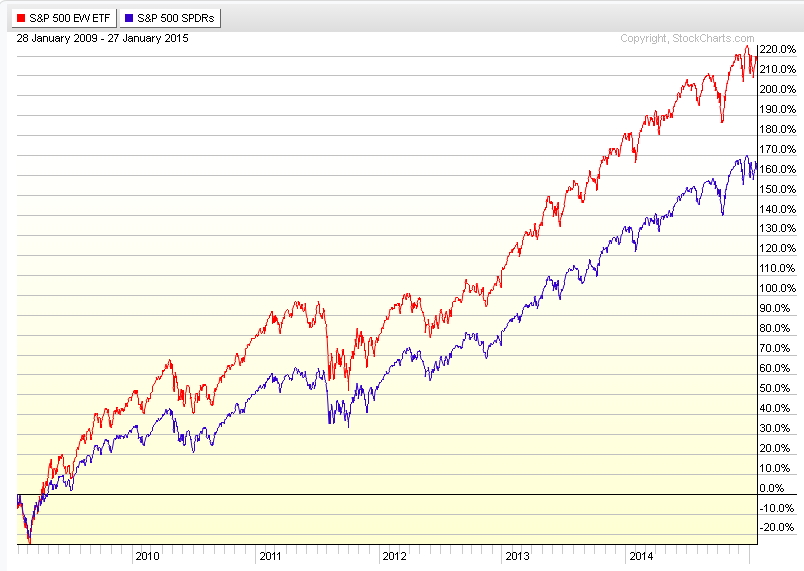If I were somehow constrained to having only two positions, I know what they would be. In actual practice, the way we build portfolios consists of 15 asset classes, not all of which we use during all market periods. But we are using these two, among others, right now because we think both are appropriate for both capital gains and income. And if I could buy only two for the current market environment, here’s what I’d buy:
The equity position would be the Guggenheim S&P 500 Equal Weight ETF (NYSE:RSP). And bonds, in this case non-US bonds, are represented by the PIMCO Foreign Bond Fund (USD Hedged) – (PFODX.) I say “represented by” because for each client we might have a number of “equivalent” securities, some of which might be more appropriate for immediate income investors, others for younger investors with a 30-year investing horizon, etc.
Most readers will recall that theS&P 500 is capitalization-weighted, so big companies with lots of shares outstanding dominate its returns. Apple (NASDAQ:AAPL), the largest component, has a market capitalization of more than $687 billion. The smallest component has a market cap just over $2 billion. It would take 300 companies that size to have the same daily effect as Apple does on the S&P 500 or its ETF clone, SPDR S&P 500 (ARCA:SPY)!
The top 10 companies (AAPL, Exxon Mobil Corporation (NYSE:XOM), Microsoft Corporation (NASDAQ:MSFT), Johnson & Johnson (NYSE:JNJ), Berkshire Hathaway B (NYSE:BRKb), Wells Fargo & Company (NYSE:WFC), General Electric Company (NYSE:GE), Procter & Gamble Company (NYSE:PG), JPMorgan Chase & Co (NYSE:JPM) and Pfizer Inc (NYSE:PFE)) comprise 17.2% of the total S&P 500 weighting. 10 stocks equal 17%, leaving 490 to share the rest. And behemoths like Chevron (NYSE:CVX), Verizon (NYSE:VZ), AT&T (NYSE:T), Merck (NYSE:MRK), Coke (NYSE:KO), Intel (NASDAQ:INTC) etc. come right behind these.
So when well-meaning writers suggest you can buy just one ETF and recommend SPY, “since it covers most of the business being done in America,” what they are really suggesting is that you buy an index that is representative of the sales concluded in the USA, but not so representative of all the companies that are doing business in the USA. You are buying, in effect, a large-cap fund.
That’s great if that’s what you intended to buy. Right now, however, I favor the mid-cap and smaller-cap firms that do most of their business here in the USA. The large-cap multinationals are today exposed to the debilitating effects of a strong US dollar. As they convert their overseas earnings into pounds, yen, euros or yen back into US dollars, they are penalized by that high US dollar. This is one of those times that it pays to seek the firms that pay their suppliers in dollars, make products or provide services domestically, and receive payment in dollars.

RSP is most representative of the top tier of those types of companies (as well as having exposure, to a lesser degree than the index itself, to the large multinationals.) RSP buys all 500 of the S&P 500 in equal amounts (not based upon a company’s capitalization). The fund then re-allocates quarterly if any company exceeds their 1/500th (0.20%) weighting in the portfolio.
There are disadvantages to this equal weighting; the S&P as measured by SPY (capitalization-weighted) tends to be heavier in tech, energy and consumer staples companies, while the equal weights are more “weighted” — simply because there are more companies at this capitalization level — in consumer discretionary, and financials. Of course, if I want representation in the US market at a time when rates are likely to rise, albeit slowly, and the economy likely to improve, albeit slowly, financials and consumer discretionary make a lot of sense.
Typically, RSP holds up better in bear markets but SPY excels in up markets. Yet, as the chart above showing results from the end of February 2009 demonstrates, over time that downside protection bias pays off! Over any long period of time, because it declines less in bear markets, RSP outshines SPY. In 2015, we believe we are better served by weighting all 500 of the S&P 500 equally. This gives us some exposure to the biggest firms but also the diversification of more mid-cap and smaller-cap (if you consider $2 billion small) firms. With its lowest-cap component coming in at $2.4 billion, I figure we’re getting a lot of mid-level domestic firms — just what we want this year.
At the other end of the spectrum are boring old bonds. Well… maybe not so boring this year. The fabulous rally in U.S. bonds over the last couple of years has taken place in the cradle of the Fed reducing rates and providing economic stimulus. That party is drawing to a close – in the USA.
In Japan, Europe and who knows where else next, however, they are just beginning to seriously reduce rates and stimulate their economies. They are where the US was 4 years ago. It is entirely possible that we might see as much return from developed-nation bonds in the coming months as we expect to see from an equity position in the US.
Please note, however, that we aren’t long PFODX because we think it will outperform the S&P 500 or SPY or RSP over any serious time frame; we own it because it serves to dampen the volatility of the S&P and our other equity positions. That’s what asset allocation is all about. If I’m correct and bond yields fall overseas, making existing bond holdings worth more, the capital gain will simply be the icing on the income and preservation cake.
The full name of PFODX is PIMCO Foreign Bond Fund (USD Hedged.) It’s the “USD Hedged” part that attracts us to this bond fund. There is no sense in buying foreign bonds for their higher yields at the same quality levels as their US counterparts if you are simply going to lose the additional income to currency conversion.
PFODX attempts to eliminate, and will likely at the very least significantly reduce, this fund’s exposure to the movement of currencies. That’s critical, given that the fund’s holdings are in Japan, the UK, Canada, euro-currency nations and Australia. PFODX sticks with the sovereign debt of the biggest developed nations, all of which yield more than their US equivalents, even after allowing for the costs of the financial futures they hedge with.

We sometimes need anchors that keep our investing boat on an even keel. PFODX does that for us, making it a key part of most of our client portfolios.
Disclosure: As Registered Investment Advisors, we believe it is our responsibility to advise that we do not know your personal financial situation, so the information contained in this communiqué represents the opinions of the staff of Stanford Wealth Management, and should not be construed as personalized investment advice.
Past performance is no guarantee of future results, rather an obvious statement but clearly too often unheeded judging by the number of investors who buy the current #1 mutual fund one year only to watch it plummet the following year.
We encourage you to do your own due diligence on issues we discuss to see if they might be of value in your own investing. We take our responsibility to offer intelligent commentary seriously, but it should not be assumed that investing in any securities we are investing in will always be profitable. We do our best to get it right, and we "eat our own cooking," but we could be wrong, hence our full disclosure as to whether we own or are buying the investments we write about.
